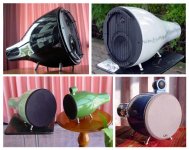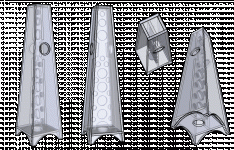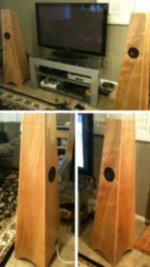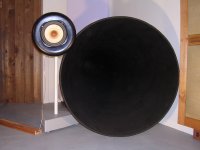Celestion SL600, one of the pioneers in metal (honeycomb aluminum panels), and one of the best compact speakers ever IMHO.
They also made a later budget 2 way speaker with an all aluminium case.
Monitor audio make a metal case speaker called Apex and Kef regularily use metal in their smaller Satellite speakers although not their Hi-fi models until you get to the high end Kef Muon.
Krell have used metal in their cab's.
Meridian use a sandwich or laminate of aluminium damped with wood. Of course you can go old school and build Gilbert Briggs style sand filled baffles and walls like Adam Audio!
Last edited:
Had listened to the Muon once. They had brought it for an audio show. You could tell that one had real R&D that made a difference.
Dave, I'm attracted to the shape of the Met and it's fairly straightforward to cast. Do you think a midsize Met, 3.5' to 5', would be a good design to demonstrate the idea? Are the TL models and drivers proved out enough or do we start a new design? I can make the detailed solid models from the basic geometry.
There are some pretty solid mets in existance. If we ever get down tobuilding a set, they will likely be bipola EL70eN (with the 2nd driver side firing).
http://p10hifi.net/tlinespeakers/FH/download/bipole-EL70-Met-0v9-090210.pdf
Bad cel phone pics of 1 of 3 sets made by one fellow.


They are of the smaller variety so will likely pose less difficulties as a test case (there is also a single driver one, plans mostly done)
dave
http://p10hifi.net/tlinespeakers/FH/download/bipole-EL70-Met-0v9-090210.pdf
Bad cel phone pics of 1 of 3 sets made by one fellow.
They are of the smaller variety so will likely pose less difficulties as a test case (there is also a single driver one, plans mostly done)
dave
Attachments
I would be a little hesitant to use Steel, Iron or any other high Iron content alloy.
Use cold rolled steel [CRS], it has the added benefit of shielding the driver.
GM
I was starting to think this forum should be renamed "The Church of Mdf".
I don't have the comparison to wood handy, but there's no doubt 1/2" of Al is more rigid than 3/4 ply, maybe 1" is equivalent? Point being the enclosure panels don't need to be nearly as thick (again minimus 7, I remember opening one up in high school) or clumsily braced.
No, it just seems that way since it's cheap and easier to route than good quality plywood and few DIYers have the knowledge/tools to work in metal. Those that can, should, though IMO.
Right, it's a dinky little cast box, but the driver can't exert much pressure on it, so it's just strong enough to survive a fall off a modest height shelf. For casting high quality and/or complex designs, brass is the historical favorite.
I've lost all my materials property data, but the usual frame of reference is that MDF has a ~527 k psi average MOE while 19 mm BB, Apple and some marine grades plywood are ~1.8 m psi and since stiffness increases at the cube of thickness, it takes ~1.125” thick MDF to be ~ as stiff as the ~3/4” thick plywood, so with larger cabs the cost gap closes significantly and the weight, extra labor penalty alone is enough for the choice to be plywood for me.
Comparing CRS Vs plywood, the gap is even greater IIRC if one has the tools or at least inexpensive access to a local metal fabrication shop as I was once fortunate enough to have, making metal the best choice of all when needing max stiffness/lb/$$ and for those with ‘deep pockets’, polished stainless steel makes for one heck of a high performance audio ‘statement’.
GM
Use cold rolled steel [CRS], it has the added benefit of shielding the driver.
GM
Thanks for the info on that one GM. I have spent some time around Aluminum and S/S, but not much experience with more ferrous content steels. Good to know that CRS would work, as it's pretty reasonably priced. While I don't have the machine shop capabilities (currently), I do have a decent bit of mechanical design knowledge, having done it for the last 6+ years.
Any idea how Cold Rolled compares to S/S and aluminum? I like the look of brush S/S or aluminum, but CRS is possible with a really nice paint job.
Peace,
Dave
You're welcome!
Don't have materials specs anymore, but should be out on the net. The SS's hardness will determine how much higher its MOE is WRT HRS, HRSPO, CRS, alum and other materials, but IIRC it takes a fairly thick alum compared to steel to match 3/4" [19 mm] 13 ply BB, apple, marine grade plywood.
Again, going from a near 'lights out' memory [I retired in '94 and wasn't allowed to keep/copy any of my technical library] as you match them up weight wise, you get ~ the same MOE and of course as you go from the hardest to softest, its 'workability' with common hand tools gets easier while welding gets harder.
For the ~casual DIYer then, bonded together sheet alum is the choice and if shielding is required, lining it with 14 ga CRS [maybe thinner for weaker motors, I only know 14 ga shielded a ~17.5 lb ceramic motored HE 15” perched right above a 25” TV’s CRT] bonded with a non-hardening adhesive or similar lossy system does double duty as constrained layer construction, allowing a thinner alum to be used and/or less bracing if it's a large cab.
Anyway, please post your findings to confirm and/or repudiate any of this.
GM
Don't have materials specs anymore, but should be out on the net. The SS's hardness will determine how much higher its MOE is WRT HRS, HRSPO, CRS, alum and other materials, but IIRC it takes a fairly thick alum compared to steel to match 3/4" [19 mm] 13 ply BB, apple, marine grade plywood.
Again, going from a near 'lights out' memory [I retired in '94 and wasn't allowed to keep/copy any of my technical library] as you match them up weight wise, you get ~ the same MOE and of course as you go from the hardest to softest, its 'workability' with common hand tools gets easier while welding gets harder.
For the ~casual DIYer then, bonded together sheet alum is the choice and if shielding is required, lining it with 14 ga CRS [maybe thinner for weaker motors, I only know 14 ga shielded a ~17.5 lb ceramic motored HE 15” perched right above a 25” TV’s CRT] bonded with a non-hardening adhesive or similar lossy system does double duty as constrained layer construction, allowing a thinner alum to be used and/or less bracing if it's a large cab.
Anyway, please post your findings to confirm and/or repudiate any of this.
GM
Metal Properties
For those who don't want to look it up, the Modulus of Elasticity for metals are, roughly,
Steel, any type 29,000,000. Hardness does not affect it much, if at all.
Stainless Steel, 28,000,000. Doesn't vary much with regards to the exact alloy. Many common Stainless alloys are non-magnetic, or weakly so.
Aluminum, 10,000,000. Varies a little with different alloys, but not enough to worry about between the alloys we'd probably be able to get our hands on for DIY use. All are non-magnetic.
Brushed stainless would be very pretty, but stainless is expensive. A possible option would be to use cold-rolled steel (CRS), brush finish it as desired, and then IMMEDITATELY clear-coat it. Depending on your local humidity, you may have minutes to days to finish the clear coating.
For those who don't want to look it up, the Modulus of Elasticity for metals are, roughly,
Steel, any type 29,000,000. Hardness does not affect it much, if at all.
Stainless Steel, 28,000,000. Doesn't vary much with regards to the exact alloy. Many common Stainless alloys are non-magnetic, or weakly so.
Aluminum, 10,000,000. Varies a little with different alloys, but not enough to worry about between the alloys we'd probably be able to get our hands on for DIY use. All are non-magnetic.
Brushed stainless would be very pretty, but stainless is expensive. A possible option would be to use cold-rolled steel (CRS), brush finish it as desired, and then IMMEDITATELY clear-coat it. Depending on your local humidity, you may have minutes to days to finish the clear coating.
First post in diyAudio! I stumbled upon this thread while re-searching cast/metal speaker enclosures, I was actually trying to find some math that showed ductile iron had comparable or better sound qualities to standard materials used in cabinet building.
Last year, I designed/cast a pair of bookshelf speaker enclosures out of Ductile Iron for a studio I was taking. I'm by no means an audiophile, but was surprised at how well they sounded when complete. I focused more on creating a pleasing form, than the actual acoustics, but would love to work with anyone here on creating an enclosure with some math behind it - after going through this thread it seems like alloys/metals are an ideal choice if you have the means of producing it.
I thought I would share some pictures of the final prototype. It uses a Dayton RS100S-8 4" Reference Shielded Full-Range Driver and I've just been using an old receiver I have laying around to power them. The enclosure itself has a variable wall thickness, ranges from ~1/8"-7/16" and some cork in the back to seal it and hold the banana plugs (which didn't work as well as I intended it too).
Some of the process can be seen here.
Last year, I designed/cast a pair of bookshelf speaker enclosures out of Ductile Iron for a studio I was taking. I'm by no means an audiophile, but was surprised at how well they sounded when complete. I focused more on creating a pleasing form, than the actual acoustics, but would love to work with anyone here on creating an enclosure with some math behind it - after going through this thread it seems like alloys/metals are an ideal choice if you have the means of producing it.
I thought I would share some pictures of the final prototype. It uses a Dayton RS100S-8 4" Reference Shielded Full-Range Driver and I've just been using an old receiver I have laying around to power them. The enclosure itself has a variable wall thickness, ranges from ~1/8"-7/16" and some cork in the back to seal it and hold the banana plugs (which didn't work as well as I intended it too).
An externally hosted image should be here but it was not working when we last tested it.
An externally hosted image should be here but it was not working when we last tested it.
Some of the process can be seen here.
Why use a magnetically shielded driver in an iron enclosure?😕
Doesn't make sense to me as it's already magnetically shielded by the enclosure itself.
I love the cast iron idea, especially if it's organically looking.
Doesn't make sense to me as it's already magnetically shielded by the enclosure itself.
I love the cast iron idea, especially if it's organically looking.
I designed/cast a pair of bookshelf speaker enclosures out of Ductile Iron for a studio I was taking.
Those are lovely, and the shape is quite good for acoutics, but could be improved a bit. I suspect they are low on volume, but i have not worked with the PE driver. I'd guess -- just off the top of my head -- that some aperiodics & a helper woofer(s) could bring them to the next level
dave
Last year, I designed/cast a pair of bookshelf speaker enclosures out of Ductile Iron for a studio I was taking...
...would love to work with anyone here on creating an enclosure with some math behind it
Dear bcloyd,
The math is all there. This shape has been studied, and the reason it sounds so well is because it prevents standing waves from forming inside the cabinet. Cabinet materials that have been tried with success are wood (carved from a single block), ceramic, marble (carved from a single block), and synthetic marble. Obviously, these are exotic materials and working with them to produce this shape is a challenge for a typical DIYer.
I know of two speaker companies holding the patents to this design. Therefore, you may want to consider licensing the technology for commercial work. Attached: some implementations using marble, ceramic and synthetic marble. Do write to me if you want to know more.

Metal rings, which disqualifies it as premium material for speaker enclosure. Just as cabinet makers would use wood to make speakers, metal workers might use metal for similar reasons etc…
Another choice is composite material. I designed my own “heavy brew” doable at home.
Each of my BLH contains 100 lb of metal powder. The powder (55%W, 40%Cu, 5%Pb) forms micro boundaries in polyester/fiberglass base. Micro boundaries of various densities absorb sound waves traveling in the composite, so there is no ringing, sound energy storage is low. The composite is stronger and stiffer than wood, it can be formed to any shape and size, so you can eliminate interior resonances haunting boxes with parallel walls. Curving flat walls also tremendously stiffens the enclosure and limits mechanical resonances. The high density non ringing material absorbs sound waves lingering in driver basket. The high density material reflects (does not absorb) sound waves traveling in air contained by horn …
The science is all there – material and enclosure is in public domain…
Warning, Lowther drivers sound good, but materials and workmanship are shoddy; mine warped and fell apart after seven years. Avoid them!!!
Marek
Another choice is composite material. I designed my own “heavy brew” doable at home.
Each of my BLH contains 100 lb of metal powder. The powder (55%W, 40%Cu, 5%Pb) forms micro boundaries in polyester/fiberglass base. Micro boundaries of various densities absorb sound waves traveling in the composite, so there is no ringing, sound energy storage is low. The composite is stronger and stiffer than wood, it can be formed to any shape and size, so you can eliminate interior resonances haunting boxes with parallel walls. Curving flat walls also tremendously stiffens the enclosure and limits mechanical resonances. The high density non ringing material absorbs sound waves lingering in driver basket. The high density material reflects (does not absorb) sound waves traveling in air contained by horn …
The science is all there – material and enclosure is in public domain…
Warning, Lowther drivers sound good, but materials and workmanship are shoddy; mine warped and fell apart after seven years. Avoid them!!!
Marek
Attachments
By the way, these speakers are cast aluminum with constrained layer damping inside:

Electrocompaniet - The Nordic Tone

Electrocompaniet - The Nordic Tone
If the thought of building a pair of cast iron speakers is not dead, I would be happy to volunteer my Solidworks skills to make some models and documentation. It would be great to try something we could make out of either MDF or Ply to be able to compare. It is clear to me that the science says that metal is more resonant than wood, but the frequency is critical to whether that matters or not. My guess is also that with the mass of a cast enclosure, the energy needed to excite resosnance won't be achieved until very high volumes where it is not really a concern.
Metal rings, which disqualifies it as premium material for speaker enclosure.
That is far too broad a generalization.
All materials ring. It is a question of where, at what Q, and howmuch
Execution is critical.
Each of my BLH contains 100 lb of metal powder
On one hand you say metal is not suitable, but then you use it for yours? It is in the execution.
dave
planet10,
Yes, my statement is too general; I was referring to cast iron, aluminum, alloys etc, I thought that all of them ring more than wood.
Knocked on fiberglass canoe sounds terrible to me, so I made my horns different way. I used heavy metal powder in the composite to change its acoustical properties; the composite containing metal powder does not behave like solid metal. I got the powder for $200, using it was less expensive than executing thicker horn walls.
The point is that with composite materials one can execute any shape and size, acoustical properties of a composite can be altered to your liking.
Yes, my statement is too general; I was referring to cast iron, aluminum, alloys etc, I thought that all of them ring more than wood.
Knocked on fiberglass canoe sounds terrible to me, so I made my horns different way. I used heavy metal powder in the composite to change its acoustical properties; the composite containing metal powder does not behave like solid metal. I got the powder for $200, using it was less expensive than executing thicker horn walls.
The point is that with composite materials one can execute any shape and size, acoustical properties of a composite can be altered to your liking.
Metal enclosures
There are hundreds of metal working or fabrication facilities in the USA (and worldwide) that use plasma, water jet, laser or other technologies to cut very precise shapes in metal. There are of course CNC routers. The company I work for uses a plasma table to cut out our stainless and carbon steel up to 1.25" thick. Our hi definition plasma still leaves a very small cant to the cut, so the cut edge is not perfectly square. However, if you desire to weld the speaker, it will easily be accomodated.
Some of our partners use lasers, which make nearly perfect cuts. We also work with one vendor who cuts steel up to 9" thick.
The point is that there are hundreds of companies who could fab up your designs and whom could be convinced to weld or machine up a speaker for you. With the new CNC tables, you can do some awesome shapes, make all the cuts just like in wood, and prebend any type of curved speaker, cube, what-ever. All metals distort when welded upon...how to accomplish what you want with a look that meets your needs is a combination of good design and craftsmanship.
I am not a metals expert, but I would suggest that a well braced speaker made of aluminum or stainless could be exceptionally good. There are many methods and materials to use to dampen resonances, which could be applied to the inside of such speakers, exactly as you would with wood or other materials.
I agree with earlier posters...it is a matter of getting the frequencies into the right range so they do not affect the sound. In the end, however, steel is very heavy. On the other hand, so are cabinets made from 2" wood, granite, MDF or similar materials. Steel is very strong for it's thickness, so the cabinet might be made smaller in overall size.
Good luck.
There are hundreds of metal working or fabrication facilities in the USA (and worldwide) that use plasma, water jet, laser or other technologies to cut very precise shapes in metal. There are of course CNC routers. The company I work for uses a plasma table to cut out our stainless and carbon steel up to 1.25" thick. Our hi definition plasma still leaves a very small cant to the cut, so the cut edge is not perfectly square. However, if you desire to weld the speaker, it will easily be accomodated.
Some of our partners use lasers, which make nearly perfect cuts. We also work with one vendor who cuts steel up to 9" thick.
The point is that there are hundreds of companies who could fab up your designs and whom could be convinced to weld or machine up a speaker for you. With the new CNC tables, you can do some awesome shapes, make all the cuts just like in wood, and prebend any type of curved speaker, cube, what-ever. All metals distort when welded upon...how to accomplish what you want with a look that meets your needs is a combination of good design and craftsmanship.
I am not a metals expert, but I would suggest that a well braced speaker made of aluminum or stainless could be exceptionally good. There are many methods and materials to use to dampen resonances, which could be applied to the inside of such speakers, exactly as you would with wood or other materials.
I agree with earlier posters...it is a matter of getting the frequencies into the right range so they do not affect the sound. In the end, however, steel is very heavy. On the other hand, so are cabinets made from 2" wood, granite, MDF or similar materials. Steel is very strong for it's thickness, so the cabinet might be made smaller in overall size.
Good luck.
- Home
- Loudspeakers
- Full Range
- Metal Speaker Enclosures ? A bad idea ?



